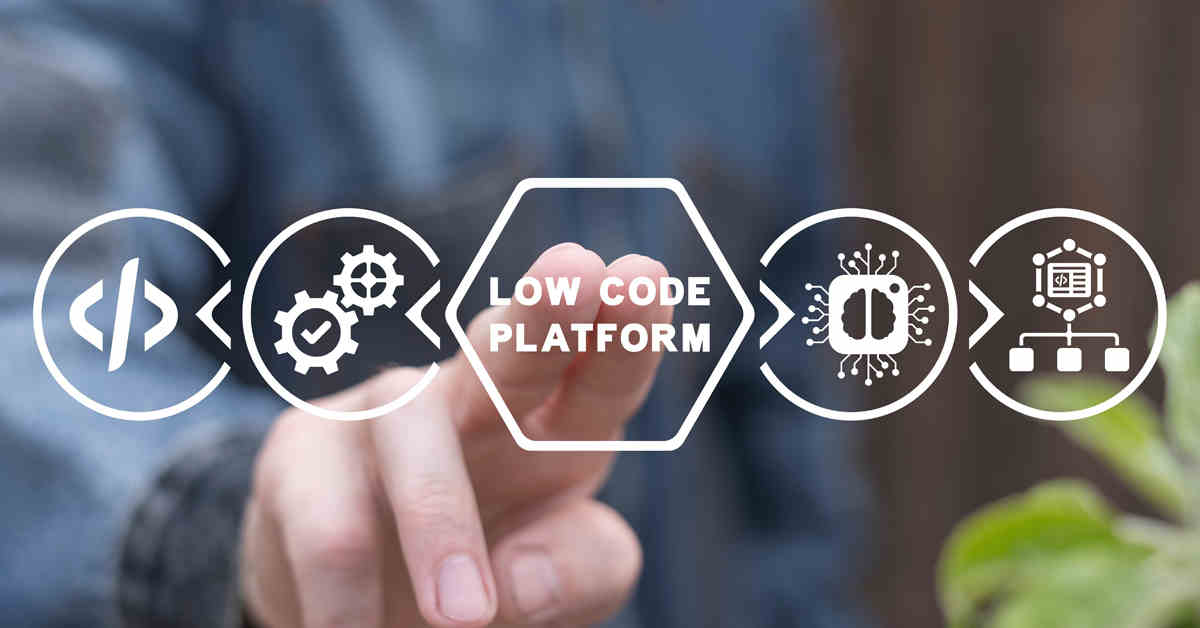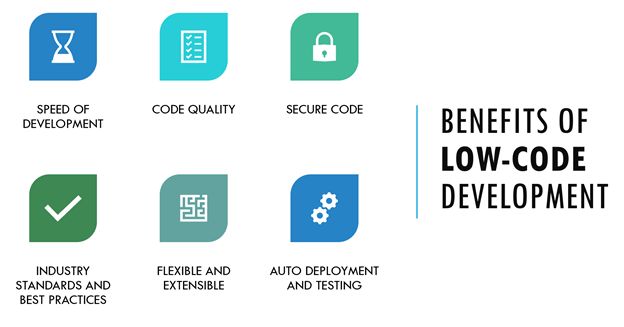Best Tips To Selecting Low-Code Platform Sites
Wiki Article
The Benefits Of Low-Code Development For Speed
Visual Development Environment:
Drag-and-Drop Interfaces: Low-code platforms provide visual tools for designing applications. Developers can build an application by dragging and dropping elements without writing code.
Many low-code platforms have built-in templates or components that enable developers to quickly build prototypes of their applications and create them without needing to start from scratch.
Reducing Coding requirements
Automated Coding Generation Low code platforms generate code automatically using the visual model developed by the developers. This helps reduce manual code, and speeds the process of development.
Reusable component: Developers are able to use the same components for different projects. This cuts down time spent on developing code and testing.
Collaboration Streamlined:
Low-code development platforms are typically equipped with tools, such as deployment, version control, and testing. This allows seamless collaboration across teams.
Citizen Development: Non-developers as well as business users can use intuitive interfaces to contribute to the development of applications, which can reduce bottlenecks caused due to a shortage of professionals to develop applications.
Rapid Iteration, Prototyping:
Fast Prototyping. Developers can create prototypes quickly to validate their ideas as well as get feedback. This leads to a faster iteration cycle.
Simple Modifications. Low-code development's visual nature allows users to modify and update their software.
Pre-built Integrations:
API Integrations: Low-code platforms usually come pre-built with connectors for popular APIs and services. This cuts down on the time required to integrate other systems.
Data Integration: Built in tools for data integration facilitate the connection between databases and other data sources. This speeds up development.
Deployment & Scaling
Many low-code platforms have the option of deploying applications with one click that reduces the time and effort needed to install applications.
Cloud-Based Solutions: Cloud-based, low-code platforms are able to manage scaling and infrastructure management and allow developers to focus on the logic of their applications and functions instead of deployment logistics.
Overall, the speed of low-code app development lies in its ability to simplify and automate various aspects of the app development process. This allows for faster delivery of applications as well as faster adaptation to changing requirements. Follow the recommended Low-code Platform for application development for website advice including cross platform mobile app development, low code development platforms, app dev platform, application development platforms, stored sql procedures, no code platforms, driver jdbc, azure sql server, build with docker, app modernisation and more.

Benefits Of Low-Code Applications In Governance And Safety
Low-code development can bring many advantages in terms of security and governance. They are essential to ensure that applications are safe, secure and well-managed throughout their entire lifecycle. Here are the benefits of developing applications using low-code:
Unified Management Console: Low-code platforms typically have a central management console, where administrators are able to oversee and manage all the applications, ensuring consistent governance across the entire organization.
Role-Based Access Control RBAC : These platforms typically have robust roles-based access controls, which allow administrators define and enforce rules. It makes sure that only users who have authorization are able to modify or access specific parts of the software.
Compliance and Regulatory Adherence
A lot of low-code platforms have integrated compliance features. For example, they are developed in accordance with industry standards regulations, laws and standards (e.g. HIPAA, GDPR). They offer frameworks and instruments to ensure that the applications are compliant with standards.
Audit Trails & Logging: Comprehensive logs and audit trails can be integrated to allow organizations to track changes, monitor access and ensure conformity.
Additional Security Measures
Data Encryption. Low-code systems offer encryption for data both at rest and when it is transmitted to ensure that sensitive data is protected.
Security Certifications: Many companies of low-code have security certifications like ISO 27001 or SOC 2, which demonstrate that they adhere to high standards. These certificates offer an additional level of security to customers.
Automated security updates
Regular Patching and Updates: Low-code platforms typically manage regular security updates and patches automatically, making sure applications are protected against the latest threats without requiring manual intervention from developers.
Security Monitoring Tools: Tools for continuous monitoring of security are provided. They offer real-time alerts, as well as insight into security issues that might arise.
Data Governance
Data Access Policies These platforms allow organizations to establish and implement their data access policies and ensure only authorized users are able to access data and that it is properly used.
Data Masking Anonymization: Built-in data masking tools and features for anonymization help safeguard sensitive information, particularly in the development and testing phases.
Consistent Lifecycle Application Management:
Development and deployment pipelines Lowcode platforms usually offer integrated pipelines for deployment and development that incorporate security tests. They ensure security throughout the entire lifecycle of an application.
Version Control. Integrated version management can help track and reverse any changes made to the application, ensuring that its integrity is preserved.
User Authentication Authorization
Single Sign-On (SSO). Support for advanced authentication and single sign-on simplifies and improves security.
Multi-Factor Authentication - Many platforms allow multi-factor Authentication that adds an extra layer of security when logging into applications.
Monitoring of Policy Enforcement:
Low-code platforms usually come with templates for policies that are pre-defined to help organizations implement cybersecurity and governance policies quickly.
Compliance Monitoring Tools - These instruments permit constant monitoring of compliance status and provide reporting, making it easy to spot and fix any issues that might arise.
Integration with Existing Security Infrastructure
seamless integration: Low-code platforms have been designed to work with current security software and infrastructure, like identity management systems and SIEM (Security Information and Event Management) solutions, and firewalls.
API Security: API integrated security guarantees that integrations with other system are secure. Keep data safe and ensure the application's consistency.
Best Practices and Training
Best practices for guideline: Several platforms include guidelines and recommended procedures for the creation of secure applications. These help non-developers meet security standards.
Security Training Some low code providers offer security training and resources to users to educate them on how to create and maintain secure applications.
Overall, the governance and security advantages assure that applications are developed and maintained in a secure manner and in accordance with regulations and in control. These platforms come with all the tools and frameworks required to safeguard sensitive data and enforce policies, while ensuring the regulatory compliance. Take a look at the top rated this post for Enterprise application development with Low-code Platform for more tips including jdbc server, develop web app, cross platform mobile dev, ms azure sql, database in azure, develop mobile application, rad development, paas service, software for app development, app dev platform and more.

Benefits Of Low-Code Application Development In Terms Of Community Support And Vendor Support
Low-code platform development provides significant advantages, including vendor support and community. This is essential to ensuring successful application implementation as well as ongoing maintenance and constant improvement. Support for Vendors
Comprehensive Technical Support:
Support Teams: Several Low-Code platforms provide access to a dedicated support team that assist with technical issues, help and troubleshooting.
24/7 Support: Some companies provide 24/7 support, which is particularly beneficial for companies that are global and operate in various time zones.
Training and Onboarding
Training programs that are structured: Vendors provide structured courses such as webinars and certification courses. This helps users quickly grasp the platform.
Personalized Onboarding: Many vendors offer personalized onboarding services to help new customers use the platform efficiently and adapt it to their particular requirements.
Regular updates and enhancements
Continuous Improvement Lowcode platform providers typically regularly release updates that contain new features, performance enhancements as well as security patches. This helps to ensure that the platform remains current and secure.
Feedback integration: Vendors will often integrate user feedback during their process of development to make sure the platform can meet the ever-changing demands of their users.
Comprehensive Documentation:
Documentation - Comprehensive Documentation: A complete and well-organized document that covers everything from basic usage to advanced customizations and is usually available. This allows users to tackle problems on their own.
API References API documentation offers complete API references that can help developers connect their low-code platform apps with other systems.
Professional Services and Consulting
Expert Consultation : Vendors offer consultancy services, including architecture design and complex implementations. They offer this service to ensure that users are able to take full advantage of the platform.
Custom Development Services: A few providers offer custom development services that allow you to build specific features or integrations that are not included in the default.
Community Support for the Community
Active User Communities:
Forums and Discussion boards: Many low-code platforms offer vibrant online communities for users to discuss ideas, ask questions and collaborate.
Local and virtual User Groups: These groups offer opportunities to connect, share knowledge and share your experiences.
Knowledge Sharing and Collaboration
Community-Contributed Resources: Users often share templates, modules, and extensions that they have developed, which can be reused or adapted by others, accelerating development and innovation.
Crowdsourced Problem Solving: The collective knowledge and experience of the community can be an invaluable resource for troubleshooting issues and finding innovative solutions to complex issues.
Learning and Development
Community-Led Training: Several communities hold workshops, training sessions, and webinars, often led by experienced users who share practical knowledge as well as advanced techniques.
Online Tutorials: Members of the community create and share many online tutorials, how tos and tutorials. These tutorials are available to all.
Feedback and Influence
Forums for Product Feedback: These forums usually offer feedback channels to the manufacturer that can affect the design of new features or improvements.
Beta Testing Programs: Active members of the community may be able to take part in beta testing programs. They will get an early look at new features and also an opportunity to shape the future of the platform.
Recognition and Encouragement
A lot of vendors offer community recognition programs. These programs honor active community members, and can include MVP programs.
Peer Support: Members of the community often offer peer support through sharing their knowledge and offering guidance for those who aren't as experienced. This fosters a collaborative, supportive environment.
Overall, the combination of strong support from the vendor with a vibrant and active community provides a comprehensive support eco-system for low code application development. The combination of robust vendor support and an active and engaged community creates a comprehensive support ecosystem for low-code development.
